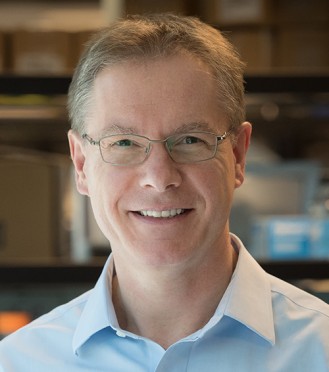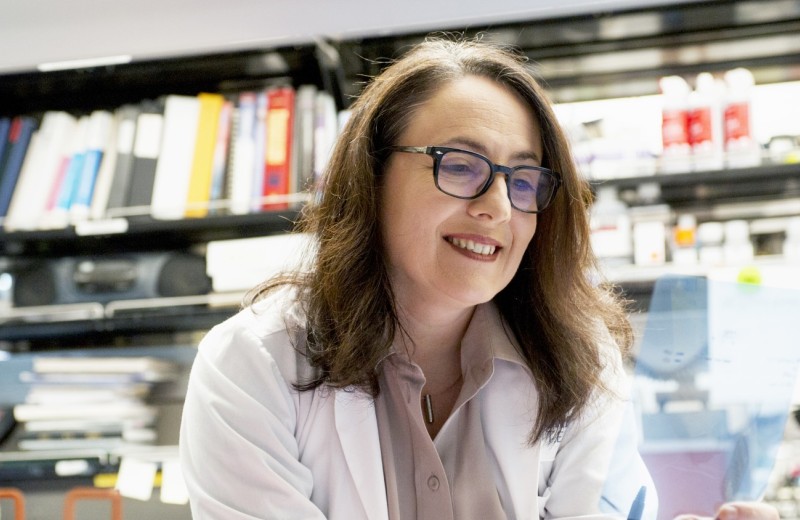Gladstone NOW: The Campaign Join Us on the Journey✕

Research into the fundamental causes of Alzheimer's disease has provided new information that brings us closer to effective treatments for dementia. [Photo: Chris Goodfellow]
When I address gatherings of people interested in Alzheimer’s disease, I am inspired by the audiences. They listen intently. They ask thoughtful questions. Inevitably, those questions come around to their most fundamental anxieties: “Are you close to finding better treatments?” “Are there ways to prevent this disease?” “Will there ever be a cure?”
Their concerns are well-placed. According to the 2015 World Alzheimer Report, nearly 47 million people are affected by dementias worldwide, and the annual cost exceeds $818 billion. In the United States, Alzheimer’s disease is the sixth leading cause of death, afflicting more than 5 million Americans, with a yearly cost of more than $225 billion. As people live longer, these numbers will increase, and without a therapeutic breakthrough, they may triple by the year 2050. In addition to the tremendous cost of this disease to our society, there is an even more devastating cost to patients, who are robbed of their memories and the very essence of their being. Last, but not least, there is the enormous impact on the caregivers.
Despite these statistics and challenges, people seek ways to remain hopeful, appropriately looking to science and medicine for answers. I can attest that the public’s desire for results is equaled by the passion and commitment of the scientific community to produce a solution. I am pleased to report that through research into the fundamental causes, we have new information that brings us closer to effective treatments for Alzheimer’s disease and other neurological disorders.
Basic Research Provides Important Insights
Basic research has already revealed that Alzheimer’s disease is caused by complex interactions among multiple genetic and environmental factors. For some time now, we have understood that one gene variant, in particular, the epsilon 4 version of apolipoprotein (apoE), produces the apoE4 protein, which is harmful to neurons. It is the first gene variation found to increase the risk of Alzheimer's and remains the risk gene with the greatest known impact. Several Gladstone research studies focus on the role of apoE4 in Alzheimer’s disease. In one recent investigation, scientists successfully counteracted the detrimental effects of apoE4 by transplanting neuron progenitors—early-stage brain cells that have the capacity to develop into mature neurons—into the brains of mouse models simulating Alzheimer’s disease, thereby replacing neurons that were destroyed by the harmful protein with healthy new neurons. Another study revealed that apoE4 production in a special type of neuronal regulator cell called an interneuron is likely an important cause of apoE4-dependent learning and memory loss. This finding provides a concrete cellular target for new drugs that can stop the destructive apoE4 at its source.
Scientists are also exploring the fundamental mechanisms of the tau protein, which has also been shown to play a role in Alzheimer’s disease also. Recent studies revealed that acetylation—a chemical process that can change the function of a protein—creates an especially toxic form of tau that impairs synaptic plasticity, an essential process involved in learning and memory. What’s more, tau acetylation may drive neurodegeneration and cognitive deficits in brains affected by Alzheimer’s disease. Fortunately, the researchers revealed that the anti-inflammatory drug salsalate, which is typically used to treat rheumatoid arthritis, both reduced tau acetylation and decreased memory deficits in a mouse model of Alzheimer’s disease.
Another promising area of research focuses on the association between the life-extending variant of the human KLOTHO gene, KL-VS, and enhanced cognition. Leading an interdisciplinary team of outstanding institutions and collaborators, Gladstone was the first research center to link this variant to better cognition in aging humans. Our work has shown that elevating levels of the klotho protein in mice simulating Alzheimer’s disease prevented several cognitive deficits and behavioral alterations. These findings further increase our hope that we can leverage klotho into better treatments for Alzheimer’s disease and related conditions.
Translational Studies
Another sign of hope on the horizon: recent research discoveries are advancing into clinical trials, an essential step in the development of new therapies. For instance, Gladstone findings highlighting the overlap between Alzheimer’s disease and epilepsy have led to a clinical trial assessing the ability of an FDA-approved, anti-epileptic drug, levetiracetam, to improve brain network and cognitive functions in early stages of Alzheimer’s disease. The design of a second clinical trial based on recent discoveries by Gladstone investigators is also under way. It will focus on blocking certain cell receptors that our team has shown to promote memory loss. Finally, building on the research mentioned above, the first clinical trial of salsalate in dementia patients has now been initiated.
These trials will all be so-called “repurposing” or “repositioning” (Phase 2a) trials, because the drugs they will test in Alzheimer’s disease have already been used for other conditions and have passed the required “Phase 1” stage, which determined their general safety. This repurposing strategy could greatly expedite the demanding process that leads from the identification of a potential drug target to the development of real therapeutics that might help millions of people.
A Narrower Focus, Personalized Care
The knowledge gained through basic science research has also helped clarify many aspects of Alzheimer’s disease and has led to a critical shift in focus. As recently as ten years ago, many Alzheimer’s disease research studies included a mix of patients across a wide range of ages of onset, stages of disease, and, most likely, causes of dementia. Just like a car is but one type of motor vehicle, Alzheimer’s disease is but one type of dementia. Although it is by far the most frequent dementing disorder, there are others that have distinct causes and likely require different treatments. Moreover, just like a car can break down for different reasons, people can get Alzheimer’s disease for different reasons, including inheritance of rare but aggressive mutations in high-impact genes or of more common genes that increase the susceptibility to factors that promote the development of the disease such as aging and traumatic brain injury. Our increasing understanding of this complexity suggests that there may be critical differences in treatment needs between, say, early-onset Alzheimer’s disease and the more common late-onset condition that currently affects 1 in 3 Americans over 80 years old.
Now, we are smarter and armed with information that can help us conduct studies in more homogeneous subsets of patients. These studies are likely to reveal that we cannot use a “one size fits all” approach to treating Alzheimer’s disease. Focusing research on specific biological causes should lead to the development of more viable therapies. In addition, whole genome sequencing and other broad scale “systems biology” strategies are already used in other areas of medicine to match patients with the most appropriate drugs. These tactics will likely also help us develop more targeted therapies for Alzheimer’s disease. Moreover, we anticipate that this “precision medicine” approach will entail using combination therapies to maximize effectiveness.
The Future and You
In considering the future of Alzheimer’s disease research and treatment, there are reasons to have hope. We know much more about the disease. We better understand many of the processes that lead to relevant changes in the brain and have identified many new entry points for therapeutic intervention. And importantly, our work is beginning to renew and ignite interest from commercial partners, which will help us in our quest to hasten the pace of new drug development.
I foresee a time when treatment of Alzheimer’s disease will be analogous to our successful approaches to other potentially devastating conditions. Hypertension is a good example. In many patients, we cannot “cure” high blood pressure, but fundamental and clinical research have led to effective drug therapies that help patients control their condition, prevent complications, and live long, fulfilling lives. One day, we will hopefully be able to say the same about Alzheimer’s disease. And at least in some types of the disease, there might even be a chance for a cure.
Lennart Mucke, MD, is the Director of the Gladstone Institute of Neurological Disease. He is also the Joseph B. Martin Distinguished Professor of Neuroscience and Professor of Neurology at the University of California, San Francisco.
For more stories about Gladstone's cutting-edge biomedical research, visit our News & Highlights.
Want to Join the Team?
Our people are our most important asset. We offer a wide array of career opportunities both in our administrative offices and in our labs.
Explore CareersScience in Seconds | The Thinking Microscope: Research Powered by an AI Brain
Science in Seconds | The Thinking Microscope: Research Powered by an AI Brain
In this video, Steve Finkbeiner and Jeremy Linsley showcase Gladstone’s groundbreaking “thinking microscope”—an AI-powered system that can design, conduct, and analyze experiments autonomously to uncover new insights into diseases like Alzheimer’s, Parkinson’s, and ALS.
Gladstone Experts ALS Alzheimer’s Disease Parkinson’s Disease Neurological Disease Finkbeiner Lab AI Big DataKaterina Akassoglou Receives Zenith Fellows Award to Advance Alzheimer’s Research
Katerina Akassoglou Receives Zenith Fellows Award to Advance Alzheimer’s Research
Akassoglou has opened doors to understanding how the blood protein fibrin is involved in Alzheimer’s and other neurodegenerative diseases.
Awards News Release Alzheimer’s Disease Center for Neurovascular Brain Immunology Akassoglou LabMeet Gladstone: Oscar Yip
Meet Gladstone: Oscar Yip
Oscar Yip is advancing Alzheimer’s research in Yadong Huang’s lab at Gladstone while drawing inspiration from his family, community, and his broader goal of helping patients.
Graduate Students and Postdocs Profile Alzheimer’s Disease




